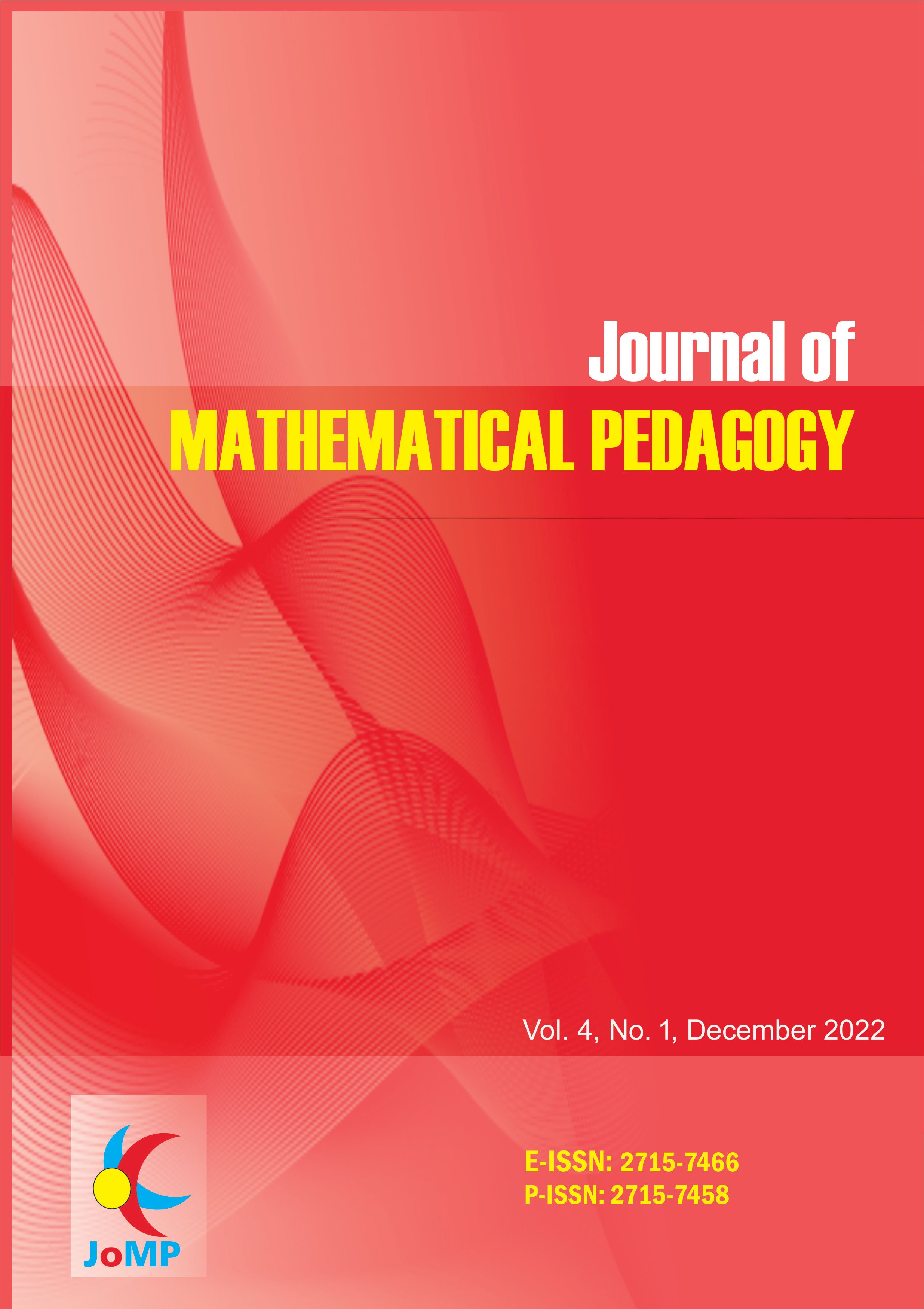Student’s Error in Solving Change and Relationship-PISA Problem and Its Scaffolding
DOI:
https://doi.org/10.26740/jomp.v4n1.p9-20Keywords:
Change and relationship, error, PISA, scaffolding, self efficacyAbstract
Change and relationship problem is considered one of the most challenging PISA problems for students. This qualitative research aims to describe students' error in solving Change and Relationship-PISA problems in terms of self efficacy and the possible scaffolding. The subjects of this study were three students who had low, medium, and high self efficacy. The instrument used was a task-based interview in the form of Change and Relationship-PISA problems. The data were analyzed according to Newman’s Error Analysis and Scaffolding by Anghileri. The results of this study show that students with low self-efficacy experienced error in transformation, proccess skills, and encoding. Students with medium self-efficacy experienced error in proccess skills and encoding. Students with high self-efficacy only met error in encoding. To overcome these error, students with low self-efficacy are given scaffolding in the form of reviewing, explaining, and restructuring. While students with medium and high self-efficacy are given scaffolding in the form of reviewing and restructuring only. Errors made by students in the problem solving process vary for each level of self efficacy, so that the way to overcome with scaffolding also needs to be adjusted.
References
Alhassora, N. S. A., Abu, M. S., & Abdullah, A. H. (2017). Newman Error Analysis on Evaluating and Creating Thinking Skills. Man In India, 97(19), 413-427.
Ambarwati, B., Hoerniasih, N., & Abadi, A. P. (2018). Analisis Kesalahan Siswa dalam Menyelesaikan Masalah Aljabar (Change And Relationship) PISA. Prosiding Seminar Nasional Matematika Dan Pendidikan Matematika (Sesiomadika) 2018, 1(1), 563-571.
Bakker, A., Smit, J., & Wegerif, R. (2015). Scaffolding and Dialogic Teaching in Mathematics Education: Introduction and Review. ZDM Mathematics Education, 47(7), 1047-1065. https://doi.org/10.1007/s11858-015-0738-8
Hadi, S., Retnawati, H., Munadi, S., Apino, E., & Wulandari, N. F. (2018). The Difficulties of High School Students in Solving Higher-Order Thinking Skills Problems. Problems of Education in the 21st Century, 76(4), 520-532. https://doi.org/10.33225/pec/18.76.520
Kaka, R., Prayitno, A., & Hamid, A. (2018). Pemberian Scaffolding Berdasarkan Kesalahan Berpikir Siswa Dalam Memecahkan Masalah Matematika. JRPM (Jurnal Review Pembelajaran Matematika), 3(2), 161-172.
Kastberg, D., Chan, J., Murray, G., & Gonzales, P. (2015). Performance of U.S. 15-Year-Old Students in Science, Reading, and Mathematics Literacy in an International Context: First Look at PISA 2015. Washington, DC: National Center for Education Statistics
Khaerunisak, K., Kartono, K., Hidayah, I., & Fahmi, A. Y. (2017). The Analysis of Diagnostic Assesment Result in PISA Mathematical Literacy Based On Students Self-Efficacy in RME Learning. Infinity Journal, 6(1), 77-94. https://doi.org/10.22460/infinity.v6i1.236
Loviasari, P. A., & Mampouw, H. L. (2022). Profil Pemecahan Masalah Matematika Pada Materi Himpunan Ditinjau dari Self Efficacy. Mosharafa: Jurnal Pendidikan Matematika, 11(1), 73-84. https://doi.org/10.31980/mosharafa.v11i1.1014
Marasabessy, R. (2020). Kajian Kemampuan Self Efficacy Matematis Siswa dalam Pemecahan Masalah Matematika. JARTIKA Jurnal Riset Teknologi Dan Inovasi Pendidikan, 3(2), 168-183. https://doi.org/10.36765/jartika.v3i2.17
OECD. (2018). Indonesia Student performance (PISA 2018), (Online), (https://gpseducation.oecd.org/CountryProfile), diakses 29 Mei 2023.
Pranitasari, D., & Ratu, N. (2020). Analisis Kesalahan Siswa dalam Menyelesaikan Soal Matematika PISA Pada Konten Change and Relationship. AKSIOMA: Jurnal Program Studi Pendidikan Matematika, 9(4), 1235-1248. https://doi.org/10.24127/ajpm.v9i4.2685
Rohmah, M., & Sutiarso, S. (2018). Analysis problem solving in mathematical using theory Newman. Eurasia Journal of Mathematics, Science and Technology Education, 14(2), 671-681. https://doi.org/10.12973/ejmste/80630
Rokhmatillah, I. N. F., Manoy, J. T., & Fardah, D. K. (2021). Profil Pemecahan Masalah Matematika Siswa pada Soal PISA Konten Quantity Ditinjau dari Self-Efficacy. Jurnal Penelitian Pendidikan Matematika Dan Sains, 3(2), 75-88. https://doi.org/10.26740/jppms.v3n2.p75-88
Schwarzer, R., & Jerusalem, M. (1995). General Self-Efficacy Scale (GSE).
She, H. C., Stacey, K., & Schmidt, W. H. (2018). Science and Mathematics Literacy: PISA for Better School Education. International Journal of Science and Mathematics Education, 16(1), S1-S5. https://doi.org/10.1007/s10763-018-9911-1
Somawati, S. (2018). Peran Efikasi Diri (Self Efficacy) terhadap Kemampuan Pemecahan Masalah Matematika. Jurnal Konseling Dan Pendidikan, 6(1), 39-45. https://doi.org/10.29210/118800
Sumule, U., Amin, S. M., & Fuad, Y. (2018). Error Analysis of Indonesian Junior High School Student in Solving Space and Shape Content PISA Problem Using Newman Procedure. Journal of Physics: Conference Series, 947(1), 1-6. https://doi.org/10.1088/1742-6596/947/1/012053
Zanthy, L. S., & Maulani, F. I. (2020). Analisis Kesulitan Siswa dalam Menyelesaikan Soal Materi Transformasi Geometri. Gammath : Jurnal Ilmiah Program Studi Pendidikan Matematika, 5(1), 16-25. http://dx.doi.org/10.32528/gammath.v5i1.3189
 Abstract views: 208
,
Abstract views: 208
, PDF Downloads: 232
PDF Downloads: 232





